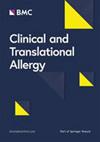Efficacy and safety of CT-P39, an omalizumab biosimilar, in chronic spontaneous urticaria: 16-week follow-up study
Abstract
Background
A double-blind, randomized Phase 3 study (NCT04426890) confirmed that CT-P39 and European Union-approved reference omalizumab (ref-OMA) were comparable in terms of efficacy, quality of life (QoL), pharmacokinetics (PK), pharmacodynamics (PD), safety, and immunogenicity up to week 24. Here, we report results from the 16-week follow-up period.
Methods
The study included two 12-week treatment periods (TPs) and a 16-week off-treatment follow-up period. In TP1, 619 patients with chronic spontaneous urticaria (CSU) were randomized to CT-P39 300 mg, ref-OMA 300 mg, CT-P39 150 mg, or ref-OMA 150 mg. A total of 579 patients continued into TP2, in which patients treated with ref-OMA 300 mg were rerandomized to CT-P39 300 mg or to continue on ref-OMA 300 mg; patients initially randomized to CT-P39 300 mg continued this regimen; and patients initially randomized to CT-P39 or ref-OMA 150 mg increased their dose to 300 mg. Efficacy, PK, PD, QoL, safety, and immunogenicity were assessed during the follow-up period.
Results
Improvements in efficacy outcomes observed in the TPs gradually decreased during the follow-up period, but did not return to baseline values. Omalizumab serum concentrations that had increased during treatment subsequently decreased during the follow-up period. After completing treatment at week 24, total and free immunoglobulin E levels returned toward baseline levels. No clinically meaningful differences in QoL, safety, or immunogenicity outcomes were observed across the treatment groups.
Conclusion
Follow-up results support the biosimilarity of CT-P39 and ref-OMA in terms of efficacy, PK, PD, QoL, safety, and immunogenicity in patients with CSU.


 求助内容:
求助内容: 应助结果提醒方式:
应助结果提醒方式:


